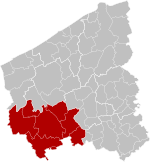The Battle of Pilckem Ridge (31 July – 2 August 1917) was the opening attack of the Third Battle of Ypres in the First World War. The British Fifth Army, supported by the Second Army on the southern flank and the French 1reArmée (First Army) on the northern flank, attacked the German 4th Army, which defended the Western Front from Lille northwards to the Ypres Salient in Belgium and on to the North Sea coast. On 31 July, the Anglo-French armies captured Pilckem (Flemish: Pilkem) Ridge and areas on either side, the French attack being a great success. After several weeks of changeable weather, heavy rain fell during the afternoon of 31 July.
In the XIX Corps area in the centre and on the right of XVIII Corps, three reserve brigades advanced from the black line to the main objective (green line) and pressed on towards the red line, the furthest that exploitation on local initiative had been allowed for in the plan. It began to rain, cutting off the advanced British troops from view, just as German regiments from specialist Eingreif (counter-attack) divisions advanced over Passchendaele Ridge. To avoid being rolled up, the reserve brigades retreated, suffering many casualties, through the green line to the black line, which the British artillery-observers could still see; the German infantry were prevented from advancing further by massed artillery and small-arms fire.
A substantial amount of ground had been captured by the British and French, except on the Gheluvelt Plateau on the right flank, where only the blue line (first objective) and part of the black line (second objective) were captured. A large number of casualties were inflicted on the German defenders during the attack and 5,626 prisoners were taken; the German Eingreif divisions recaptured some ground from the Ypres–Roulers railway northwards to St Julien, forcing the British back to the black line. For the next few days, both sides made local attacks to improve their positions, much hampered by the deluges. The rains had a serious effect on operations in August, causing more problems for the British and French, who were advancing into the area devastated by artillery fire and partly flooded by the unseasonable rain.
A local British attack on the Gheluvelt Plateau on 2 August was postponed several times because of the weather until 10 August and the second big general attack, due on 4 August, did not begin until 16 August. The green line objectives on the Plateau were not captured until the Battle of the Menin Road Ridge on 20 September, after the principal role in the offensive was transferred to the Second Army and three weeks' sunshine and fresh breezes dried much of the ground. The Third Battle of Ypres became controversial while it was being fought, with disputes about the predictability of the August deluges and for its mixed results, which in much of the writing in English is blamed on apparent misunderstandings between Gough and Haig and on faulty planning, rather than on the resilience of the 4th Army.









